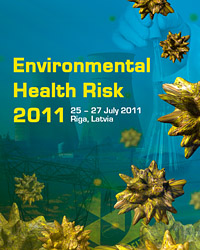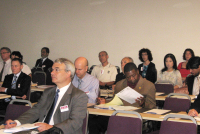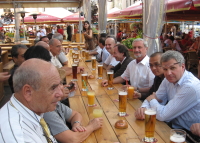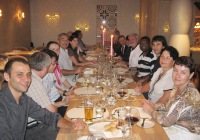Environmental Health Risk 2011
6th International Conference on the Impact of Environmental Factors on Health
25 - 27 July 2011
Riga, Latvia
Overview
 The 6th International Conference on the Impact of Environmental Factors on Health (Environmental Health Risk 2011) has recently taken place in Riga, Latvia, organised by the Wessex Institute of Technology, represented by Professors Carlos A Brebbia and Viktor Popov, and Riga Stradins University, represented by Professor Maija Eglite.
The 6th International Conference on the Impact of Environmental Factors on Health (Environmental Health Risk 2011) has recently taken place in Riga, Latvia, organised by the Wessex Institute of Technology, represented by Professors Carlos A Brebbia and Viktor Popov, and Riga Stradins University, represented by Professor Maija Eglite.
We live in a world of unprecedented changes. Life on the Earth is fragile, and every living being can continue to exist only in the environmental conditions optimal for its life. There is a common view that the progress of the human civilization is measured by, among other indicators, progress in science, urbanization, agricultural ability, industrial developments and transportation to provide means for more comfortable life. The majority of the population chooses urban over rural life because of the various advantages that life in cities offers. However, in many cases, the closer one is to the cities, the risks to health due to air pollution, traffic, radiation fields, noise, and many other factors increase. This observation underlines the impact of industrialization, urbanization and other anthropogenic activities on the environment. There is now a growing awareness of the negative effects of technological development on the environment and on human health due to exposure to environmental contaminants. One of the highest current priorities of society is to create a more sustainable way of future development with less detrimental impacts.
The field of environmental health is defined by the problems faced and by the specific approaches used. These problems include, amongst many others, the treatment and disposal of liquid and airborne wastes, the elimination or reduction of stresses in the workplace, purification of water supplies, the impacts of overpopulation and inadequate or unsafe food supplies, and the development and use of measures to protect the population from being infected with a variety of diseases.
Opening Address
 The conference was opened by Professor Carlos Brebbia who explained the aims of the Wessex Institute and its emphasis on interdisciplinary research. WIT has developed powerful computer models which are used for solving a wide range of problems, including not only engineering cases but also environmental problems related to the topics of the conference.
The conference was opened by Professor Carlos Brebbia who explained the aims of the Wessex Institute and its emphasis on interdisciplinary research. WIT has developed powerful computer models which are used for solving a wide range of problems, including not only engineering cases but also environmental problems related to the topics of the conference.
The Institute sees itself – Professor Brebbia said – as a mechanism for knowledge transfer, bringing together people from many different fields and scientific disciplines. This is reflected in the twenty five or so meetings organised by WIT annually in different locations around the world.
WIT concentrates on research activities, including a PhD programme and a very active division dealing with industrial research. This has led to opening an office in Boston (USA) to serve the American market, including its armed forces.
An important part of the Institute's activities is reflected in the large number of publications published by WIT Press, its academic publishers. They comprise a number of books including conference proceedings and monographs as well as a series of Journals which cover topics not properly served by current publications. These Journals which are very successful in terms of quality of papers, are Open Access and widely disseminated throughout the world.
Another service recently launched by the Institute has been the release as Open Access of all papers presented at WIT conference from 1993 to 2009, comprising under 25,000 different articles (see http://library.witpress.com)
This Environmental Health Risk conference is one of the interdisciplinary activities promoted by WIT, bringing a variety of scientists together. The reason for this is that the serious problems facing our world today can only be solved by the interaction of different disciplines and stakeholders, technical solutions are not sufficient on their own.
Professor Brebbia mentioned the importance of scientists such as the late Ilya Prigogine, Nobel Prize winner for Chemistry, whose work is now the foundations of many new interdisciplinary solutions. The views of Prigogine – who was Honorary Chairman of one of WIT’s conferences as well as Honorary Editor of the International Journal of Design and Nature, are now remembered by the setting up of the prestigious Prigogine Gold Medal instituted by WIT and the University of Siena and awarded annually to an outstanding scientist following the ideas of Prigogine.
Finally, Professor Brebbia explained some of the developments taking place in the New Forest campus of the Institute and invited the participants to come and visit WIT to be able to judge better its work and find ways of collaborating.
Keynote Address by Professor Maija Eglite
The conference was opened by a keynote address given by Professor Maija Eglite, Co-chair of the conference and Head of the Department of Occupational and Environmental Health at Riga Stradins University. Her presentation analysed the work conditions and occupational morbidity in Latvia during a 15 year period to provide recommendations to the employment policy programme. The results demonstrated that one third of measured occupational risk factors exceeded the recommended limits. Traditional work risk factors (chemical, physical, biological etc.) have been partially replaced by new risks (ergonomic and psychosocial factors).
Invited Presentations
Other invited presentations were the following;
‘Breath odor characteristics after drinking alcoholic beverages and health monitoring’
by Takashi Oyabu, Kawazawa Seiryo University, Japan
‘Vegetation fires and release of radioactivity into the air’
by Fernando Carvalho, Instituto Technologico e Nuclear, Portugal
‘Assessment of diesel particulate matter exposure among underground mine workers’
by Dean Bertolatti, Curtin University, Australia
‘Groundwater quality on a waste disposal area due to sand mining activities in São Paulo State, Brazil’
by Edson G. de Oliveira, State University of Sao Paulo, Brazil
‘Thermal comfort in operating rooms: a case study’
by Francesco Patania, University of Catania, Italy
‘Multiscale comparison of air quality modeling for an ozone occurrence during the 1996 Paso Del Norte Ozone Campaign’
by Paul Tchounwou, Jackson State University, USA
Conference Sessions
Other papers presented at the meeting were grouped into the following sections;
- Air pollution
- Risk prevention and monitoring
- The built environment and health
- Food safety
- Occupational health
- Ecology and health
- Water quality issues
Social Events and Excursions
The conference was characterized by the high level of discussions, many of them informal, encouraged by the friendly atmosphere and the numerous different social activities that took place at the meeting.
Delegates were able to have complimentary lunches together and they were also invited to dinner at the end of the first day in order to get to know each other better. This took place in a beer garden type of restaurant where they could experience the excellent local drink and have a tasty dinner. The convivial and friendly atmosphere helped to cement the contacts amongst the delegates.
A tour took place during the conference to introduce the delegates to some of the unique sights of the city. The tour was on bus and foot, and conducted by an excellent guide who was very well versed in the history of the city as well as the many events that took place in the region of the Baltic since the Teutonic Knights’ conquest. The delegates and their partners were able to see the most significant sights of Riga – views of the City Canal parks, the Bastion Hill, the Powder Tower, the Freedom Monument, the Opera House and other theatres amongst others. They also walked along streets where most of Riga’s Germanic Art Nouveau buildings are located. These buildings are the best examples of their type in the world. The walk took the participants along the streets of the old Hanseatic city, strolling along the cobblestones to see the Dome Cathedral, the church of St Peter, the old Guild Houses, the Swedish Gate and many other museums and historical buildings.
The excursion provided the delegates with an occasion of further strengthening their contacts in a relaxed atmosphere.
Conference Banquet

The conference banquet took place in arguably the best restaurant in town, whose catering is in demand for official functions and other public occasions. The menu consisted of a fresh fish appetizer followed by lamb and ending with a selection of home-made desserts. The menu was accompanied by excellent Chilean Sauvignon and Argentine Malbec wines. The atmosphere of the banquet, which took place in a private room was most convivial and friendly.
Publication of Proceedings
The proceedings of Environmental Health and Biomedicine, 512pp (Print ISBN: 978-1-84564-524-3; Online ISSN: 1743-3525) are available in paper and digital format from WIT Press priced at £220/US$440/€308. Orders can be placed on the WIT Press web site at www.witpress.com or by email: This email address is being protected from spambots. You need JavaScript enabled to view it., telephone: +44 (0) 238 029 3223 or fax: +44 (0) 238 029 2853.
Papers from the conference will also be hosted online at the WIT eLibrary as Volume 15 of WIT Transactions on Biomedicine and Health (Online ISSN: 1743-3525). For more details visit the WIT eLibrary at http://library.witpress.com


 Wessex Institute
Wessex Institute